Operations of Company “I”, 8th Infantry – east of Olzheim
It was June 2008 when we for the first time visited the battlefield along the Prüm river, thanks to my good friend Edwin van Engelen who found an interesting after action report of I Company / 8th US Infantry Regiment. We visited several spots according to this after action report an had an interesting day. The unfamiliarity of this battle triggered me to do more research, and after more than a decade this website shows a part of the result. The after action report was made by Captain Claude E. Bailey, commander of “I” Company and the report was later used in military studies, in an advanced course for officers. Another bonus is that reports like these give a detailed and personal insight of the events that occurred during the Prüm river crossing in 1945. Although the battle at Kleinlangenfeld is only a small part of the bigger picture, it gives the reader interesting facts and some kind of feeling of what the men experienced more than 75 years ago. The story starts on February 27 when the plan and orders for the attack were announced. What Captain Bailey and his company experienced on February 28th and in particular on March 1st 1945 can best be told by himself.
PLANS AND ORDERS
On the morning of 27 February the company commanders were called to the battalion command post where the battalion commander announced that the long expected attack was scheduled to jump off the following morning. With this effort all along the VIII Corps front, it was hoped and expected to break through the Prum River defences and make a quick drive to the Rhine.
The mission of the 4th Division was initially to establish a bridgehead in the Willwerath – Gondelsheim – Fleringen – Rommesheim area. The 11th Armored Division, which was presently in a corps assembly area had been ordered to attack through the 4th Division zone not later than 3 March. After being passed through, the 4th was to follow the 11th Armored to clean out any pockets of resistance which might have been bypassed.
The job of establishing the Willwerath bridgehead fell to the 8th Infantry. Within the regiment, the 2nd Battalion received order to cross the river at Hermespand, take the large hill immediately east of town, and be prepared to take Weinsheim on order. The 3rd Battalion was to take Kleinlangenfeld and the large hill southeast of it; be prepared to clear the high ground south of the town and capture Willwerath on order. The 1st Battalion was to continue as the regimental reserve.
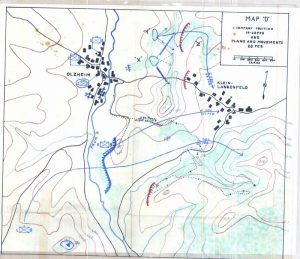 The 3rd Battalion commander, Lieutenant Colonel Fred W. Collins, after discussing possible plans for the battalion attack, took the company commanders to an observation post in L Company area, for another look at possible approaches into the enemy positions. The hill on which the observation post was located gave excellent observation of the high ground directly across the Prum, but neither Kleinlangenfeld or Willwerath could be seen. The observation post hill also was a prominent terrain feature from the German viewpoint, and the addition movement in the thin woods brought six rounds of artillery crashing in. Sudden occupation of convenient holes prevented any damage. On return of the group to the observation post, Lieutenant Colonel Collins issued his attack order. K Company was to assault Kleinlangenfeld from the southwest; L Company to take hill 618, southeast of the town, and assist K Company if necessary; I Company, less two platoons, to attempt to pass through the minefield between woods Y and Z, clear woods Z and attack Kleinlangenfeld from the northwest (See map). Two platoons of I Company would constitute the battalion reserve initially, and in the event the minefield could not be passed through, the entire company would revert to the reserve. One of M Company’s heavy machine gun platoons was attached to K Company, and the other to I Company. The 81mm mortars could support the attack from their positions in Olzheim.
The 3rd Battalion commander, Lieutenant Colonel Fred W. Collins, after discussing possible plans for the battalion attack, took the company commanders to an observation post in L Company area, for another look at possible approaches into the enemy positions. The hill on which the observation post was located gave excellent observation of the high ground directly across the Prum, but neither Kleinlangenfeld or Willwerath could be seen. The observation post hill also was a prominent terrain feature from the German viewpoint, and the addition movement in the thin woods brought six rounds of artillery crashing in. Sudden occupation of convenient holes prevented any damage. On return of the group to the observation post, Lieutenant Colonel Collins issued his attack order. K Company was to assault Kleinlangenfeld from the southwest; L Company to take hill 618, southeast of the town, and assist K Company if necessary; I Company, less two platoons, to attempt to pass through the minefield between woods Y and Z, clear woods Z and attack Kleinlangenfeld from the northwest (See map). Two platoons of I Company would constitute the battalion reserve initially, and in the event the minefield could not be passed through, the entire company would revert to the reserve. One of M Company’s heavy machine gun platoons was attached to K Company, and the other to I Company. The 81mm mortars could support the attack from their positions in Olzheim.
Time of attack was to be 0530, with no artillery preparation, and silence stressed until contact was made. In this connection, the division order had set the time of attack to be at 0615 (dawn), and the 22nd Intantry, on the right og the 8th, planned to precede their attack with a 15-minute artillery preparation beginning at 0600. However, the regimental commander of the 8th Infantry, as well as his battalion commanders, felt that in his zoned surprise would be vital to the rapid and cheap achievement of the objectives. Therefore, he requested, and was granted, permission to initiate his attack at 0530 in order to save a half hour before the enemy became thoroughly alerted by the artillery firing for the 22nd. This decision proved to be very advantageous to K Company in its assault on Kleinlangenfeld.
In planning for the penetration of the minefield, the I Company commander was well aware that bangalore torpedoes were the desirable tools to use for the job, but their tremendous explosions would destroy secrecy even more efficiently than would artillery fire. Previously, artillery and mortar concentrations had been placed on the minefield in an effort to blast gaps in it. Adjustment of the fire could be made only by sound and observation of drifting smoke because the open area between Y and Z could not be seen from woods X. Further, only mortar fire had trajectory high enough to reach the ground between the woods. Artillery shell with the correct range to hit the space burst in the treetops of wood Y. However, additional concentrations were fired during the day to explode all mines possible.
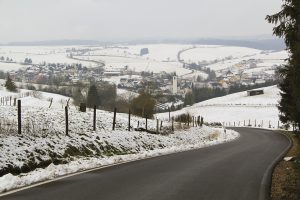
The weather at this time was generally clear. Snow, which had until recently covered the ground, was all gone except in the deepest shade. The mines had been laid while the snow was several inches deep, and it appeared possible that few, if any, had been covered with earth for concealment. Patrols had reported hundreds lying exposed on the ground all along the crest of the ridge north of the Olzheim-Kleinlangenfeld road. Among those observed were wooden-box Shu mines; cylindrical cement blocks, complete with imbedded metal fragments, internal explosive charge, pull type fuse, and trip wire; and what appeared to be “Bouncing Betties”. Those mines and trip wires which could be seen were not to be feared especially, for wires could be cut and box lids lifted. Therefore, it was hoped in this case that the Germans had not gone so far as to bury any pressure-type under ground. Since, on the 27th, I Company’s 1st Platoon was in support of Olzheim, the company commander planned to use it as the rifle strength of the attack, leaving the 2nd and 3rd Platoons in position as battalion reserve. In addition, the attached machine gun platoon would cover the crossing of the minefield from positions in the forward edge of woods Y. The light machine gun section was to follow the 1st Platoon through the minefield, then move up on the right flank. The 60mm mortar section was to stay in its present positions initially, prepared to fire into the edge of woods Z, follow the other platoons on order, and as early as possible, take positions from which fire could be placed on Kleinlangenfeld. The company commander, accompanied by the 300 radio operator and two messengers, one with a 536 radio, would move with the 1st Platoon. The first sergeant and the remainder of company headquarters were to remain in Olzheim as a rear command post. The company executive officer, Lt. Joseph P. Thomas, a twice wounded D-Day veteran, remained behind as commander of the battalion reserve. Accordingly, order were issued in the company command post on the afternoon of the 27th. A patrol was sent to locate, or clear, a safe route to the forwards edge of woods Y. That evening, then the “chow jeep” arrived, one day’s “K” ration and extra cigarettes were issued. After dark a forward observer party – a lieutenant and two radio operators – arrived from the 29th Field Artillery Battalion.
THE MINEFIELD
At 0445 28 February, heavy clouds blotted out a bright moon as the company started to form on the road. Even so, visibility was good enough to be able to distinguish moving forms at about 25 yards. It was cold and raw, but not freezing, Telling the first sergeant to notify battalion and the platoons on the ridge positions that they were on their way, the company commander started the Olzheim elements moving at 0500, the time of attack.
Moving silently in single-file, the column crossed the footbridge, reached and skirted the edge of woods X where the heavy machine gun platoon joined to follow the 1st Platoon, paralleled the scrub growth, and entered woods Y. At the 3rd Platoon position, the light machine gun section tagged on the end of the column. The squad leader, whose patrol had reconnoitred and cleared a safe route, guided the 1st Platoon on up to the forward edge of the woods without incident. Although several shell craters could be seen in the open area, it was evident that not much had been accomplished by the concentrations toward blasting a gap through the mines. The 1st Platoon leader, Lt. George L. Siewenie, after choosing as well as possible the best crossing location, deployed two squads to cover the remaining squad which was to do the dirty work of leading off through the minefield. The heavy machine guns were moving up, one section on each side of the rifle platoon and about 30 yards from it, so fire of the four guns could be crossed in front of the platoon.
The sky in the east was brightening now, and the company commander heard K and L Companies report to battalion over the 300 radio that they were moving out. Many mines could already be seen in the open space, and, as everything was as ready as could be, the company commander motioned Lt. Siewenie to start his leading men out.
A man on hands and knees, his rifle slung across his back and with wire cutters in one hand, moved gingerly out from the woods. He was followed at five yards by a second man, slightly to the right, so as to widen the path. Using their hands even more than their eyes, they carefully searched the ground immediately in front of them. As each slowly went forward, he cut trip wires, throwing the ends well aside, and lifted lids of Shu mines, pushing the boxes out of the way.
Two members of the squad had engineer tape which they were to use to mark the path. They did not get to use it, for as the first man reached a point about 12 yards out, there was a terrific explosion followed by a brilliant flare which dispelled all remaining darkness. The second man had hit a buried pressure-type mine with his knee. Even with haste, snow and partly frozen ground the Germans had been thorough. As the flare died out, two shouts in German were heard just over the crest of the ridge, but no firing was forthcoming. The men who had been hit was pulled carefully back to the woods, but it was too late. He had died instantly.
In the dead silence that followed the flare, it occurred to the company commander that both he and the battalion commander had overlooked the possibility that an accidentally exploded mine might alert the Kleinlangenfeld defenders as well as any of the other noises the battalion was avoiding. As yet however, no firing was heard from the direction of the town. The company commander called battalion on the SCR300 and reported the situation. Lieutenant Colonel Collins agreed that no further effort to get through the minefield should be made at that time, and directed the company to return to its previous positions. Depending on how the K Company situation developed, I Company might breach the minefield later using bangalores. The decision to return to Olzheim was received by the 1st Platoon with noticeable relief. As the men were beginning to move back through the woods, a sudden outburst of machine gun fire and rifle firing came from the direction of Kleinlangenfeld. A few minutes later the K Company commander was heard reporting that his company was in the first buildings on the edge of town, having gained almost complete surprise.

The division artillery could now be heard firing far to the south, and immediately to the north, the artillery supporting the 87th Division attack was booming. Enemy shells began falling more frequently into Olzheim as the company was re-crossing the footbridge, but all men of the 1st Platoon and the sections reached their buildings safely. Moving on toward the company command post, the command group heard the characteristic sound of approaching Neberlwerfer (“screaming meemie”) shells and scrambled for the dubious protection of a pile of rubble. A close explosion showered dirt and stones on the three men. The noise of more of the same starting on their way sent the group dashing the few remaining yards to the command post. The company commander’s headlong dive down the cellar steps was somewhat cushioned at the bottom by the radio operator who had preceded him by a very slight margin. When the incoming shells slackened, the company commander went to the battalion command post to learn what he could of the situation. During the morning, frequent reports came in form K and L Companies. K Company was meeting very strong opposition in Kleinlangenfeld, but was making slow progress in house-to-house fighting. In the early morning L Company had moved several hundred yards towards its objective without being discovered, then was hit with heavy rifle and machine gun fire from woods P. The company was split by the fire, and although the two leading platoons were able to get past and continue on, the remained could move neither forward nor back because of their exposed position. Late in the morning the forward position of L Company was reported on hill 618, their objective.
Throughout the day repeated attempts were made to neutralize woods P by heavy mortar and artillery concentrations, but they seemed to have little effect on the fire from the woods. On the 3rd Battalion right, the 2nd Battalion had also gained initial surprise in the attack, although they were now having difficulty in trying to capture the large hill east of Hermespand. The Germans were reinforcing their position from Weinsheim.
Still no order were forthcoming for I Company. It appeared that in view of K Company’s slow but steady gains in Kleinlangenfeld, I Company would not be used to breach the minefield and attack through woods Z. At about 1600 the company commander was called to the battalion command post. The battalion commander informed him that the pinned-down portion of L Company had been withdrawn under cover of smoke placed on woods P, and that as soon as darkness fell, it would try to re-join the company with re-supply. He added that the forward element of the company was holding its position on the hill, having repulsed two minor counter-attacks so far, but he was worried about the situation in that zone. The enemy in woods P would have to be eliminated and the hill 618 position strengthened. He wanted I Company to move out during the night, attack woods P at daylight 1 March, clean out the enemy position there, then go into position on the high ground between hills 617 and 618, and make contact with L Company.
Back at his own command post, the company commander called the platoons on the ridge positions. He directed the platoon leaders to report to the company command post after having their seconds-in-command start moving the platoons back to Olzheim. The 1st and Weapons Platoons had first lieutenants permanently assigned as their leaders. The 3rd Platoon was commanded by a technical sergeant, and Lt. Thomas, although nominally the company executive officer, led the 2nd Platoon in most combat actions. The 2nd Platoon sergeant had been in all the heavier engagements since D-Day, had been three-times wounded and twice decorated, but, although thoroughly competent as second-in-command, had previously evidenced tendencies toward combat exhaustion when given the full responsibility for leading the platoon. For that reason it was felt that an officer should lead it when ever possible.
When the platoon leaders arrived, the company commander outlined the situation, the mission and his plan. The company would move out in columns of twos at 0230 1 March in the order: 3rd Platoon, Light Machine Gun Section, 2nd Platoon, Heavy Machine Gun Platoon, Company Headquarters, including artillery forward observer party, Mortar Section and 1st Platoon. Sight contact would be maintained between platoons. The route would be: cross the footbridge, turn right (south) and follow the unimproved road paralleling the Prum River to the third right angle bend; east across the south slope of hill 599 (mistake, should be hill 588), skirting the north edge of the woods; south across the stream and road, then into the woods to get in position to attack woods P at daylight. The leading platoon would provide a four-man patrol to precede the column at the limit of visibility, protect and prevent surprise. The 2nd and 1st Platoons would put out flank guards where necessary. The company commander with the 536 and 300 radio operators would move with the 3rd Platoon for control purposes. The time remaining before moving out was spent in the usual preparations. A hot meal was served, all men oriented, maps and photos studied, ammunition and weapons checked, and K rations issued. At 2300 battalion informed the company commander that the L Company platoons had been fired on as they were moving to join the rest of the company, but they had managed to get through.
OPERATIONS 1 MARCH
The company started to form at 0215. The night was clear, cold and dark; the moon not yet up. After eyes became adjusted, starlight gave faint visibility, and the moon would soon help. The 3rd Platoon began to move at 0230, and the rest of the company strung out behind in the prescribed order. The pace was necessarily slow, not only because of the darkness, but also adjusting to the speed of the machine gun platoon man-handling their heavy guns. Soon after crossing the footbridge, the head of the column turned right on the unimproved road, and the advance patrol moved out a few yards ahead. The road curved sharply west toward the river, south to parallel the river for about 400 yards, east for 250 yards, then south again. As the company left the road at the last bend to continue east, it spread out more and flank guards went out as far as they could be seen on each side of the column to protect the company across the open ground. It seemed to be getting lighter, and the black blob that was the woods on the slope of hill 588 could be dimly seen. With the head of the column halfway across the open space, the leading patrol hurried on to investigate the edge of the woods. In a short time one man came back bringing two very young, subdued and frightened German prisoners. He told the company commander that the woods were clear, the patrol was waiting at the forward edge for the company and further instructions, and that the prisoners had been caught asleep just inside the woods. A German speaking messenger questioned them, and said they had deserted from Kleinlangenfeld where they thought they would be killed or captured by K Company the next day. The company commander had them taken to the headquarters group with instructions to bring them along. He didn’t want to spare any men yet to take them back to battalion.
The company reached the woods and followed its north edge. The head was almost up with the patrol when a whispered, “Hold it up”, was passed forward along the column. Looking up the slope to the left, the company commander saw a flank guard signalling. A moment later four figures appeared against the skyline. They halted suddenly at a low command from a flanker, and their rifles clattered to the ground. When these Germans were brought down to the company, they stated they were a patrol sent from Kleinlangenfeld to make contact with the group in woods P. They either could not or would not give any information concerning the strength of the position at P. While the company commander was with the patrol leader pointing out the direction to move from there two more Krauts wandered in to the company. These simply said they were lost. As eight prisoners were too many to try to carry along, two men of the 1st Platoon were designated to take them to battalion. The situation and location of the company were reported, and the lead patrol was off again.
The route now was south down the slope to cross the stream and road. The rising moon made visibility excellent for a hundred yards or more. Getting across the road without discovery seemed to be the most difficult phase of the movement, for it was somewhere in this vicinity that the rear elements of L Company were fired on earlier in the night. The stream proved to be no obstacle as the water was shallow, and the shoe-pacs all men wore prevented wet feet. The platoons were instructed to wait until the preceding platoon had disappeared into the woods immediately on the other side of the road, then cross the stream and road as quickly as possible. The flank guards were called in before the crossing, for sight contact with them would be impossible in the woods. The 3rd Platoon waded the stream, scurried across the road picking up the waiting patrol as it went, climbed the very steep bank, and entered the woods, where it immediately began to flounder.
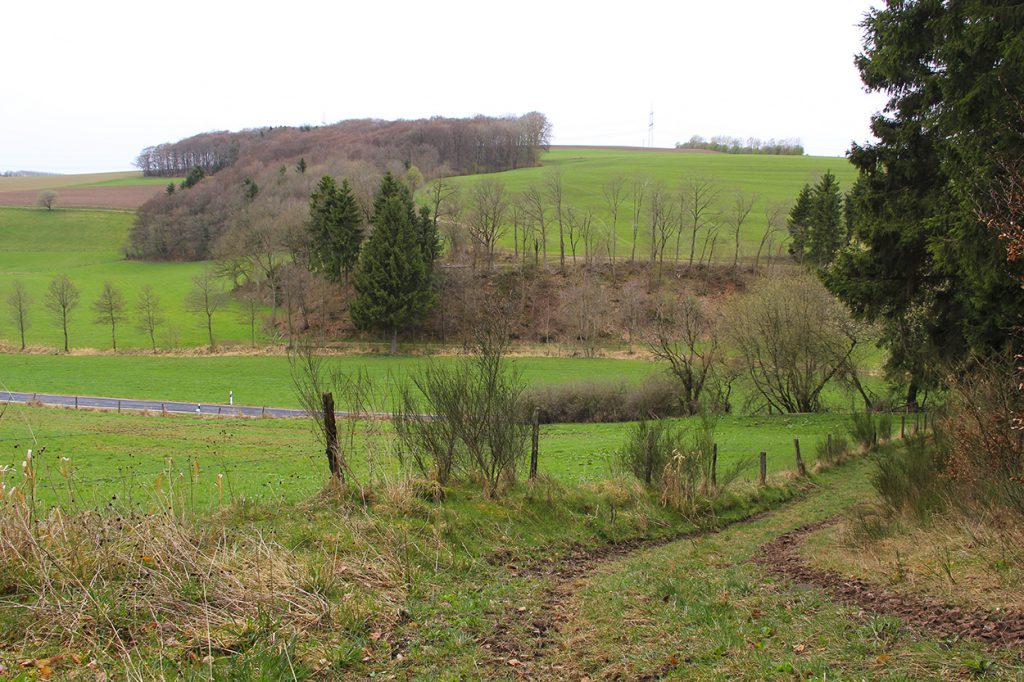
The woods, consisting of some sort of evergreen trees, were extremely dense and with a heavy growth of underbrush. It was readily apparent that the company could not force its way through there with any semblance of silence. The company commander, motioning the platoon leader to move the 3rd Platoon back out, returned to the road, sent a messenger to tell the rest of the company to sit tight until signalled forward, and started searching for a suitable route into the woods. A short distance down the road (west) a small stream, coming from the high ground to the south, flowed into a larger stream just crossed. The woods were not so thick along this stream, and a trail seemed to parallel it. The lead patrol was directed up the trail followed by the 3rd Platoon, and the other, still across the road, were signalled to come on. About a hundred yards from the road the trail went through a wooden gate in a wire fence and curved to the east, going up the hill. To follow the trail farther would lead the company away from woods P, so the company commander recalled the patrol and went with it to the right, across the small stream, to a corner in the fence. Here the fence made a right angle and went south, straight up the side of the ridge on which woods P was located. The lane out in the woods for the fence was wide enough for the company to move in single file, and the column was directed up that way. The time was about 0445, still approximately an hour and one half before dawn. The company commander felt he was well behind woods P now, and the main problems were to find the break between this woods and those at P, and to locate some less dense spot to use as an attack position.
Two-thirds the way up the very steep ridge, another whispered “Hold it up” came forward along the column. The panting men sank down, grateful for the break. The company commander sent his messenger up to tell the patrol to go on the top of the ridge to observe, then hurried back down along the column to learn what was wrong. At the tail of the 2nd Platoon, the men said the machine gun platoon wasn’t behind them. Lt. Thomas had already gone back to find them. Almost to the stream, the company commander saw the wayward platoons coming back through the gate. Carrying their heavy loads, the machine gun platoon had been slow in crossing the large stream and road, and had not seen the 2nd Platoon turn right at the gate. Mumbling something like “should’ve left a guide”, the company commander struggled up to the head of the column again.
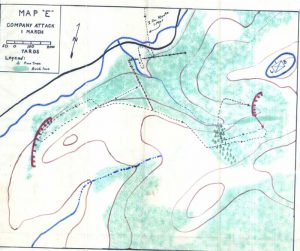
The messenger who had been sent to the patrol was back. He reported that the edge of the woods was not far ahead, and that he had seen another lane running off to the right from this one. Looking down it could see open ground about a hundred yards away. The column began to move again, the patrol was sent forward and instructed to turn right on the new lane. As the messenger had stated, the lane soon ended. With the patrol at the open ground, the column was halted while the company commander was trying to decide where to go from there. The two lanes cut out a triangular patch of woods. Looking back along its hypotenuse, to the left rear of his present location, the company commander saw that the edge of the woods went diagonally up toward the top op the ridge and curved off to the south. This ridge seemed to merge with another running north and south. It was on the latter high ground that the company was supposed to take positions later in the day. Looking forward (west) along the direction of movement, the edge of dense woods continued straight out, paralleling the top of the ridge about 50 yards below the crest. All the ground left of the woods to the ridge crest was bare and open, gleaming brightly in the brilliant moonlight.
The company commander was talking to the patrol leader when the man observing from the mouth of the lane whispered sharply, “Captain, look!”. There about 25 yards away, coming along the woods directly toward the company, was a column of Germans. They were moving silently and had their weapons slung on their shoulders. The company commander glanced hastily to the rear, saw that the 3rd Platoon was some 20 yards away back in the lane and unaware of what was taking place. He motioned the patrol out of sight and whispered, “Don’t shoot unless they see us.” His first impression was that this was a supply detail coming back from the position at P, and he did not want to prematurely alert the position.
The Germans came on, passed the mouth of the lane within 20 feet of the company, and continued up along the woods. There were approximately 30 of them. As the last one passed the lane, the company commander and the automatic rifle man of the patrol stepped out in the open behind them. Whispering, “If they see or hear anything, let ‘em have it,” he watched the group disappear up the ridge. Apparently they had noticed nothing, and neither had any of the rest of I Company. With the three rifles, one carbine, and one automatic rifle immediately available for use, a good percentage of the approaching Germans could have been liquidated before the remainder dove for safety in the woods. However, caution was still uppermost in the company commander’s mind, and the fleeting opportunity was soon lost.
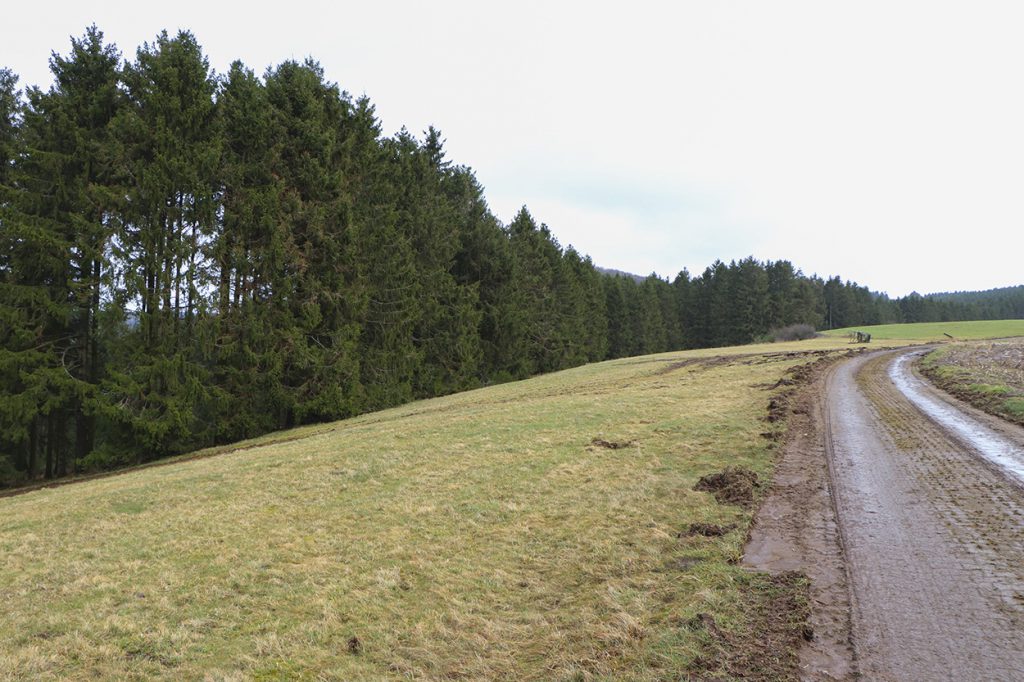
Getting back from wondering whether his decision had been wise or foolish, the company commander and the patrol went forward along the tree line to try to locate the open space between this woods and woods P. They found it about 200 yards out. It was merely a fire break, some 15 yards wide. A man was sent back to bring the company up, and the company commander searched for a way to get into attack position in the woods before reaching the fire beak. This was not as difficult as expected, for, in addition to the fact the woods were not quite so thick here, many artillery and mortar rounds, aimed at P on the previous day, had fallen beyond and helped thin out the underbrush.
When the column approached, the company commander pointed out the fire break to the 3rd Platoon leader as the line of departure for the attack, told him to move his platoon down into the woods far enough for the light machine gunners and the 2nd Platoon to be on his left, and still within the woods, deploy in a skirmish line, move to the fire break, and remain in observation until ordered to attack. The 2nd Platoon was placed on the left with similar instructions, and the light machine gun section in the center between the two rifle platoons. Lt. George Pritchard, commanding the heavy machine gun platoon, placed one section on the right of the 3rd Platoon and one section to the left of the 2nd Platoon to give supporting fire as necessary. Lt. Siewenie was directed to hold his 1st Platoon just inside the woods and protect by observation to the rear and across the open ground to the top of the ridge. Positions for the mortars were non-existent unless they went out in the open, so they were not emplaced, but stayed in concealment. The headquarters group also picked a comfortable spot and awaited developments.
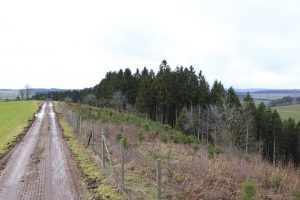
The time was now 0605, and it was rapidly getting lighter. Woods P seemed to be an entirely different type from those the company was in – much less dense, the trees were not evergreens, and there was little underbrush. The company commander checked the line to see that all was ready, took position between the 2nd and 3rd Platoons and at 0620, used the 536 radio for the first time with the command, “Let’s go.” The platoons rushed across the fire break, entered woods P, and in 15 minutes reached the other side of it on the nose of the ridge. Not a shot was fired. Plenty of Krauts were there, but they were all dead, wounded, or craven in their holes. The artillery and mortar fire of the day before had done a terrific job in working the position over. Three bursts had sprayed open foxholes, direct hits on log-covered dugouts had blasted them apart, and scarcely a tree was un-scarred by fragments, but still the Germans had been able to continue firing from the position. Questioning brought out the fact that all the others had pulled out early in the morning, not bothering about the wounded. The uninjured said they had still been too shaken or scared to go with them.
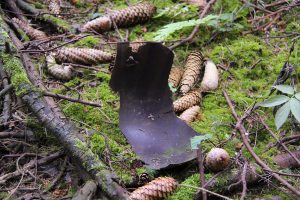
While the platoons were making another thorough search of all foxholes and dugouts and giving first aid to the German wounded, the company commander called battalion. He informed the battalion commander as to what had taken place and stated that he was about ready to move on to the company’s final position. Lieutenant Colonel Collins told him there was a modification in plan, and directed that one platoon of the company was sent around the nose of the ridge and south to Willwerath. Its mission was to clear the several houses north of the road running east out of the town. The rest of the company would continue on to the previously assigned final objective. Over protests that the platoon would be without support and very possible without communication, Lieutenant Colonel Collins said he had no one else to send, that no activity had been noted in or around the houses, but that they had to be checked and held to protect the 2nd Battalion’s left flank.
The new job was assigned to the 1st Platoon. The company commander told Lt. Siewenie that in the event the 536 radio would not reach the company, a relay station would be set up here on the nose of the ridge to pass on any messages or calls for fire. The platoon was quickly oriented and moved out.
The remaining platoon leader were assembled and the plan for the completion of the mission was outlined. Lt. Thomas was directed to hold his platoon there, organize the able-bodied prisoners to carry as many of the wounded as possible, and detail some of his men to take them back to battalion. He was given the 3rd Platoon’s 536, complete with fresh battery, and instructed that, if before re-joining, he got notification from the company commander, he was to establish the relay station with two more of his men somewhere on the ridge. In the meantime, company headquarters, 3rd, heavy machine gun, and weapons platoons would go to the higher ground and start digging in. Accordingly, the 3rd Platoon again led off, initially retracing its path of the early morning. This time a pair of scouts was well out in front and a right flank guard on the top of the ridge.
Reports from Lt. Siewenie indicated his platoon was nearing the first house, having seen no enemy yet. However, his transmission was becoming progressively weaker, so Lt. Thomas was radioed to set up the relay station. The first relay message was that the platoon had been fired on, but was in a food position and about to make a rush for the first house. This was reported to the battalion commander with the request that the platoon’s progress be watched from the observation post, is possible, and all available assistance given them. A few minutes later, another message stated the platoon was in the house firing at a located enemy position. The relay station said the message was very faint, and a short while later, reported they could get no answer from any call, regardless of where they moved the radio. Nothing further was heard from the platoon until much later in the day, after it had accomplished the mission and battalion headquarters gained contact.
The company was now nearing the juncture of the ridge it was on with the high ground running generally north and south. The dense evergreen woods, along which the company was moving, gave way to a belt of pines which led off to the south. As the 3rd Platoon headed east into the pines, the dreaded sound of rockets coming that way sent the company diving to the ground. The salvo exploded out in the open ground, slightly wounding two headquarters messengers. One of these looked in amazement at a gaping hole in the top of his helmet and probed gently at a small gash in his head. He found the fragment lodged in his helmet liner, and carefully tucked it away in a pocket, saying that his grandchildren would be interested in seeing it. An aid man patched them both up, and they headed in the direction of Olzheim and the aid station, apparently happy with their “million dollar wounds”. It was later reported that somewhere down in the valley on their way, they kicked the trip wire of a mine and were again fortunate. They continued on, one of the two having lost the seat of his pants and gained another slight scratch.
No more enemy fire fell in the vicinity, and it was not believed that the single salvo had been directed particularly at the company. Moving on into the pines, the company was halted while the commander and platoon leaders went forward on a rather hasty reconnaissance for a defensive position. He was more than half convinced that any Germans who might have been on this ridge had withdrawn by now. Beyond the pines the ground sloped gradually upward for about 80 yards, levelled off for a short distance, then fell off again to the east. Approximately 75 yards down the forward slope very thick woods began again. Between the belt of pines, along the crest and down to the other woods, the ridge was lightly wooded – widely spaced trees, no underbrush or small growth. Visibility and fields of fire were not hampered much by the trees except to the north. There a line of bushes and young trees ran from a point near the crest, over the ridge, and almost to the dense woods. To the south about 50 yards, the open woods ended, giving way to bare ground which extended for some 200 yards.

The company commander did not know the exact location of L Company toward the north, but felt that it couldn’t be very far away. He planned to start organization of his position, then send a patrol to make contact. Completing the quick reconnaissance, the group moved back toward the pines. They had not gone beyond the bush line to the north, but as they neared the company, sounds resembling voices and rattling equipment seemed to come from the other side.
Commenting that it must be part of L Company, the company commander told the 3rd Platoon leader to send a couple of men over to find out. The men were dispatched, and the three platoons moved out to their assigned sectors to begin digging their holes. A short while later the two-man patrol returned and reported, “They’re GI’s, sir.” Asked if he was sure, one replied, “Yes, sir, we saw them.”
The company position was to be half-horseshoe-shaped, the open end to the northwest, and with the greatest strength facing east and south. The light machine gun section and one heavy machine gun section was placed near the left end of the line to fire northeast to east. The mortars were emplaced near the pine belt. The 3rd Platoon with a strength of 19 men was the only rifle unit available at the time, and it was going in on the south and southwest portions. The 2nd Platoon, which was expected to re-join very shortly, would cover the east portion, extending the line north from the left machine guns. The heavy bush line which limited observation to the north and somewhat to the northeast, was about 50 yards to the left (north) of the flank machine gun. Assuming L Company was just beyond the line, little attention was paid to it.
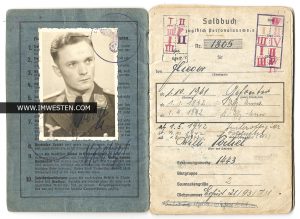
The company commander met Lt. Pritchard, the machine gun leader, and walked with him to his left section. Standing behind the guns and about 15 yards from the left one, they watched the crews digging emplacements and individual holes. Both guns were set up and loaded, pointing east. Two riflemen, temporarily sent over to this side from the 3rd Platoon, had fond a convenient two-man hole already dug about halfway between the guns, and were relaxing and eating a K-ration. A rifle shot cracked, and a man at the left gun fell to the ground and lay still. It seemed to come from the left rear. The second man at the gun jumped to his feet, stood behind a small four-inch diameter tree, and peered around it. Immediately there was another shot, and the back of his jacket was seen to puff out slightly as a round black hole appeared. The company commander from his now prone position cursed the “trigger-happy fools” of L Company, but an outburst if machine pistol fire and more rifles left no doubt as to who was shooting. The right machine gun was caught as it was swinging around to fire, the water jacket was pierced, ammunition belt mangled, and the gunner wounded. All men close to the two guns were forced to keep down by the hail of bullets. A heavier machine gun began adding its voice to the din. The company commander wriggled backward and gained the protection of a small depression. He yelled back to a larger depression, where the command post had been set up, for the 3rd Platoon to be sent up. He still could not determine exactly where the fire was coming from. However, he did know it came from the left rear within the bush line.
The slope of the ground prevented the present fire from hitting the south portion of the company position, but it the Krauts overran the left of the line and reached the point where the commander was now, they could take all the rest of the company under fire from the rear. That the Germans were closing in became obvious, and the left of the line was in no condition to stop them. Not seeing any of the 3rd Platoon coming, the company commander yelled to Lt. Pritchard to get back, crawled to the command post, sent word by messenger to all elements on the south side, including the 3rd Platoon, to get to the pine belt and assemble there. A few Germans broke from the bush line and were approaching in short rushes.
With the 1st sergeant and two other men of the command post group, he fired as fast as possible to assist the return of Lt. Pritchard’s men. Five, including Lt. Pritchard, scrambled back. All then made a dash for the pines, evidently unseen by the Germans. The heavy firing continued for about two minutes, then dwindled and ceased entirely.
Under the cover of the pines, a check revealed that eight men were missing – two of the 3rd Platoon and six of the machine gun platoon. Two heavy machine guns had been left on the position, and in his haste to get back, one man of the artillery forward observer party had abandoned his half of their SCR610 radio. Burning with anger at his own negligence and stupidity, as well as at the false report he had received the company commander told the 3rd Platoon and the light machine gun section to get ready to flank the enemy from the north. He radioed Lt. Thomas, who reported that the 2nd Platoon had been moving up when the firing started and now was almost to the pines. They appeared in a few minutes. That platoon now had 13 men, all others having been designated to return the prisoners, guide litter bearers from the aid station, or man the relay station, which was still trying to contact 1st Platoon.
The commander briefly oriented Lt. Thomas, told him to combine the men of the 2nd and 3rd Platoons into a composite platoon an be ready to go as soon as possible. The mortar section, headquarters group, and remaining portion of the machine gun platoon were directed to stay in the pines, with Lt. Mozgo, the weapons platoon leader, in command. Lt. Mozgo was to establish security, place the mortars so they could fire on the position just vacated and send a mortar observer with the attacking group. Lt. Thomas soon had the composite platoon and the light machine gunners organized, and without further delay, they were motioned to move out. While the preparations were being made, battalion had twice called to learn the situation. The radio operator and 1st sergeant had given the information, but before the attacking force had gotten far, the operator ran up to say the battalion commander wanted to talk to the company commander. Signalling Lt. Thomas to keep going, the company commander stopped to take the handset of the radio. Lieutenant Colonel Collins asked if I Company alone could regain the position or whether assistance from L Company was desired. He was informed that the attack was already underway, and no assistance was felt necessary – as yet, anyhow. Saying he would call later, the company commander signed off and ran on to catch up with the platoon. He was in no mood to cry for help before at least making a strong effort to get revenge.
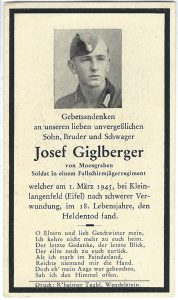
The plan was to move north in the pine belt, cross a ravine, which was the head of the second stream crossed in the early morning; get on the next small ridge and turn east to the lever ground atop the main ridge; deploy further and sweep south through the thin woods to the old position. This route and movement worked out well. The pines ended at the ravine, the ground on the other side being lightly wooded. After turning east and reaching the level ground, the scouts signalled, and the platoon moved up to join them. This point was estimated to be about 300 yards north of the old position. No enemy could be seen. The platoon faced south, deployed as skirmishers, the light machine guns went up on the left flank, and all moved rapidly along the ridge crest. The line had not gone far when, through the trees ahead, a few Germans were seen idlely moving around. Wanting to get as close as possible, the platoon continued without firing until there was a sudden shout and heads snapped around to our direction. Immediately, Lt. Thomas’ submachine gun fire was the signal for all weapons in the line to open up. Some startled Germans fell, others scrambled for holes and dugouts. One, running with a burp-gun in his hands, was caught in the chest by a burst of fire from one of the light machine guns and crumpled in a heap. Snarling and yelling excitedly, the platoon surged forward, firing at every step. The gun crews on the left leapfrogged their guns, one gun firing while the other rushed forward a few yards to hit the ground and began shooting again. They kept abreast of the platoon in that manner, firing continuously. This blanket of marching fire, although not particularly accurate had the very desirable effect of making the enemy keep their heads down and hesitant about shooting back. However, a machine gun opened up from the position, followed by several rifles and a machine pistol. Although the fire was largely wild, some men of the platoon hit the ground to shoot prone. Realizing that speed was highly essential, being only about 40 yards from the position now, NCO’s got them up quickly. In a rush the platoon closed on the nearest foxholes. One of the captured 3rd Platoon men, in grave danger of being hit by our fire, was jumping up and down in wild excitement, yelling and waving, “Come on, come on!”. The Kraut machine gun was seen to be fired by a hand reaching up from a hole and pulling the trigger. A hand grenade stopped it abruptly.
Germans jumped from holes with upraised hands and frightened eyes. A sergeant killed one who came out shooting. Others were brought from their holes at gun point. A group of four made a dash across the open ground for the woods down the ridge. One reached that protection, although he was seen to stumble before getting there. He was the only man to escape from the position. The far edge of the position was soon reached and all firing ceased.
The position had been established to face northwest and southwest, was well camouflaged and dug in, with logs and dirt as overhead cover for the foxholes and dugouts. It was about 75 yards from the bush line, and it was evident that at least two men had earlier been posted in the bushes to observe the south. This time no chance was taken with security, and men were immediately spotted at four places around the area to observe, protect and give warning while reorganization took place. Of the eight men previously missing, two were dead, three were wounded – one seriously, and three unhurt. They said the Germans had treated them well, bandaged the wounded men, and were about to take them to the rear when the attack started. The artilleryman’s half radio was recovered intact but neither of the two heavy machine guns could be used in their battered condition. After collection of the prisoners and a re-check of all the holes, the results of the attack were found to be: 32 prisoners, seven of whom were wounded; six dead; four machine guns; two machine pistols (burp-guns); other assorted weapons and equipment. The cost to the attacking composite platoon was one bullet-burned arm.
Six rounds of light mortar fire fell near the men on the ridge, but no one was hurt. The lone escapee had probably passed on information of what had happened. Lt. Mozgo was called to bring up the elements still in the pines, a five-man patrol was sent north to definitely locate and contact L Company, and a call was placed to battalion. The situation was reported, litter bearers and re-supply of ammunition was requested. Lieutenant Colonel Collins said he thought the company could expect to remain where it was for the night; the 1st Platoon would re-join about dark; a wire line from battalion would be installed; and the company supply sergeant sent up with ammunition, rations, cigarettes and blanket rolls.
The prisoners, assisting their own walking wounded, and the wounded of I Company men who were able to walk were dispatched to Olzheim. The prisoners, on being hastily questioned, had said there were more positions to the east, but did not know whether the ridge from here south to Willwerath was still occupied. One stated that a force of 300 was forming somewhere to the northeast, and planning to attack this ridge that night. Although that sounded more like bluff than truth, L Company was notified. A perimeter position was set up, using the existing German-dug holes as much as possible, and all platoons were tied in with sound-power telephone communication. The patrol returned, accompanied by the L Company executive officer. L Company was located about 500 yards to the north. The patrol had gone and returned along the top of the ridge, and, although it saw some German-dug strong points, no enemy were sighted. The battalion wire team arrived with an EE-8 field phone and the telephone line. Litter bearer teams carried the American and German wounded out. In the late afternoon the 1st Platoon and the various prisoner guard details came up bringing supplies for the company. With the position organized and one man in each foxhole continuously alert, the company settled down for a cold, quiet night, uneventful except for the jangle of the telephone telling the commander to move out again before dawn.

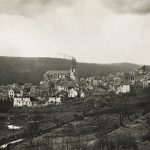
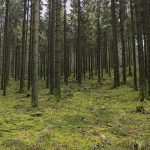
Build an elegantly modern, responsive website that’s creative, accessible and beautifully presented. A well-designed website can change your conversion and a profit for good.
Sed malesuada dolor eget velit euismod pretium. Etiam porttitor finibus pretium. Nam suscipit vel ligula at dharetra.
Curabitur ac nisl molestie, facilisis nibh ac, facilisis ligula. Integer congue malesuada eros congue varius. Sed malesuada dolor eget velit euismod pretium. Etiam porttitor finibus pretium. Nam suscipit vel ligula at dharetra.